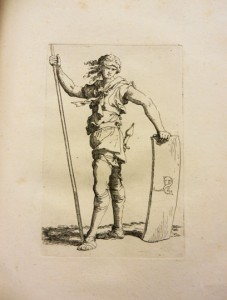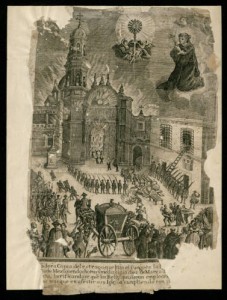
The following comes to us courtesy of Julia Taylor, Graduate Fellow of the Carey C. Shuart Women’s Archive and Research Collection.
While Friday’s SCOTUS ruling on marriage equality marks a milestone in the struggle for LGBTQIAP rights, Special Collections’ booth at this year’s Houston Pride documented the genealogy of LGBT activists who set the stage for this historic win.
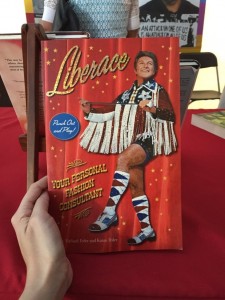
Edward Lukasek’s copy of Liberace: Your Personal Fashion Consultant, a book of Liberace paper dolls emblazoned with life mottos, was a crowd-pleasing favorite.
This year’s Pride festival and parade took place in downtown Houston instead of the usual shady Montrose locale, making the air-conditioned atmosphere of the LGBT History tent a welcome respite from the Texas heat. Special Collections proudly exhibited rare books and artifacts from the Edward Lukasek Gay Studies Collection and the Norma Lee Gay Studies Collection, as well as papers and ephemera from the Houston Area NOW Collection, the Debra Danburg Papers, and the Kanellos Latino Literary Movement Book Collection. Library staff and volunteers stood by to answer questions and show support as families, couples, and friends perused the display of historical and literary materials.
The LGBT history tent, which was sponsored by AT&T, also housed exhibits from Rice University Special Collections, the Botts Collections of Lesbian, Gay, Bisexual, and Transgender History, the Houston Public Library, and the Old Lesbian Oral Herstory Project. To learn more about the history of Houston Pride, visit their website.
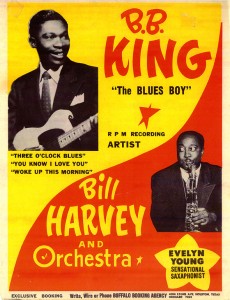
promotional poster for B.B. King and Bill Harvey & Orchestra (Texas Music Collection)
Today marks the last day of visitation before the King of Blues is laid to his final rest at the B.B. King Museum and Delta Interpretive Center. On hearing the news of this music legend’s passing nearly two weeks ago, one could not help but pause and reflect on his storied career that made him synonymous with the blues and even extended his broad cultural imprint beyond music. Here at the University of Houston Special Collections, Houston and Texas History Archivist Vince Lee shared some of his ongoing work as part of a digitization project and its surprising connection to B.B. King.
The Texas Music Collection contains research files on the history of Texas music, with an emphasis on the musicians and record labels of the mid-twentieth century. There among the newspaper clippings, songbooks, and financial records, Lee points out, are promotional photographs of some of the most renowned musicians to call Houston home–including the late B.B. King.
King’s brand of the blues may always be associated with Beale Street and his deep Memphis roots, but the reasons why his photograph might show up in an archival box in Houston are likely less well-known. A recent piece in the Houston Press by Chris Gray is an excellent primer on the King-Houston connection and references the research of Dr. Roger Wood (author of Down In Houston: Bayou City Blues) on the role music business mogul Don Robey played in King’s connection to Houston.
Founder of Peacock Records, the Houston native Robey acquired Duke Records (previously based in Memphis) with the same business aplomb that marked his other interests and acquisitions, giving him easy access to a roster of talented Memphis-based musicians and industry connections. Among those connections was a young B.B. King. Though King never signed with Duke/Peacock, it was natural that the Houston-based Buffalo Booking Agency representing B.B. King (also owned by Robey) would help stock his touring band with musicians from Robey’s many record labels and with plenty of what Wood calls that “Texas tenor, big-band sound.” These tours, Wood argues, maximized B.B. King’s exposure to audiences and were critical in his professional success.
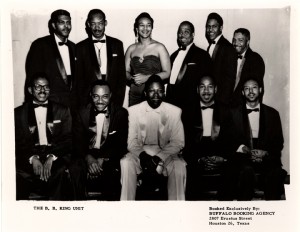
promotional photograph for the B.B. King Unit (Texas Music Collection)
Materials from the Duke/Peacock label feature prominently in the Texas Music Collection and promotional photographs from the Buffalo Booking Agency are not hard to find. One promotional photograph for the B.B. King Unit features a very young-looking luminary flanked by his band, including vocalist Mildred Jones (booked exclusively by Buffalo Booking, Houston, TX, the fine print reminds us).
These promotional photographs, that also include other greats like Junior Parker, “Gatemouth” Brown, and Johnny Ace, are another example of the surprises found in the archives on a daily basis. As we remember B.B. King, we are also thankful to have these reminders of his career and legacy. Interested researchers may request the Texas Music Collection in the Special Collections Reading Room during our normal hours of operation.
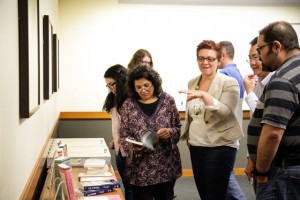
Attendees and panelists mingle, discuss, and view some of Mena’s works. Additional photos of last month’s event can be viewed here. (Photo courtesy of Mauricio Lazo, University of Houston Libraries.)
Last month Arte Público Press and the University of Houston Special Collections came together to celebrate María Cristina Mena (1893-1965) in an event that honored her writings and highlighted the gift of her papers to our Hispanic Collections. Mena was an author probably most known for her children’s books and short stories, including some published in The Century Magazine and American Magazine from 1913 to 1916 (though she continued to write and publish up until just before her passing in 1965).
The event was held in Special Collections at the MD Anderson Library on campus. Honored guests Amy Doherty Mohr, PhD of Amerika-Institut at Ludwig-Maximilians-Universität Munich; José Aranda, PhD of Rice University, Department of English; and Carolina A. Villarroel, PhD of Arte Público Press and the Recovering the U.S. Hispanic Literary Heritage Project, served as panelists for the event which was moderated by Lisa Cruces, Archivist for our Hispanic Collections.
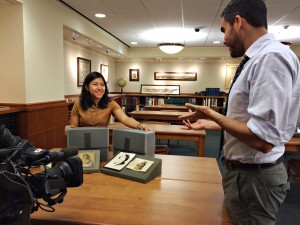
Hispanic Collections Archivist Lisa Cruces highlights the María Cristina Mena Papers for the cameras of Houston Public Media.
Some of the major themes in Mena’s works include beauty (and plastic surgery), language, stereotypes, and women and romance. In her stories, these themes were often used to explore aspects of the Mexican and American components of her Chicana/o heritage, especially the intersections in which these two components collided. Attendees had an opportunity to hear from a wide array of panelists, both local and virtual (in the case of Dr. Mohr who was able to join the conference from Munich), whose research interests were able to provide more context and definition to Mena’s writing, life, and place among the literary output of the 20th century. “Thrilled” with this new addition and its research potential, Cruces notes, “The Mena Papers offer a wealth of information ranging from insight on experiences of female authors in the early 20th century to the literary depiction of the Mexican Revolution abroad.”
Our thanks to all who helped make the event a success. The María Cristina Mena Papers, part of our larger Hispanic Collections, are available for research in the University of Houston Special Collections Reading Room.
In addition to the over 7,000 linear feet of archival collections made available for study at the University of Houston Special Collections, we are also proud to offer over 100,000 rare and antique books for use in our reading room. Each month we will highlight a text from our collections and what makes it so special.
This spring semester we have been fortunate to host our first-ever UH Special Collections Social Media Intern, Shelby Love. As part of her duties, Love has been curating our Book of the Month series here on the blog. For this month (and many to come, no doubt) we share a Book of the Month selection from Shelby Love.
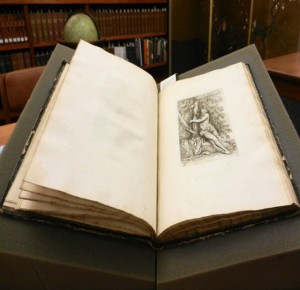
Salvator Rosa has ludentis oty Carolo Rubeo singularis amicitiæ pignus D.D.D. open to display female figurine
Book of the Month: Salvator Rosa has ludentis oty Carolo Rubeo singularis amicitiæ pignus D.D.D.
Why so Special? Salvator Rosa has ludentis oty Carolo Rubeo singularis amicitiæ pignus D.D.D. is a series of etchings by Salvator Rosa, an Italian painter and printmaker. The book was dedicated to Rosa’s Roman patron Carlo de’ Rossi. The book contains beautifully detailed portraits of peasants, women, and groups of soldiers as well as some mythological scenes. Rosa is considered to be one of the most original artists and bizarre characters of the 17th century.
The collection in this book features many etchings from Rosa’s figurine series, which went on to influence many Italian artists as elegant “stock” figures to incorporate into their works. Without the ability of color, Rosa’s traditional prints illustrate the versatility of the line to distinguish subject from object, light from shadow, and detail from outline.
This item presents a rare opportunity to experience the intricate and original artwork without the unfortunate distortion and separation of museum glass. The texture of the plate is softly written into the fabric of the paper and the viewer can also see the indention made into the paper from the plate’s edges after being run through the engraving press. These details bring the viewer excitingly close to the printmaking process that was used to create these images in a way that only originals can. Aesthetically engaging and enlightening, this collection by Rosa is just one captivating gem in Special Collections.
Location: Those interested in viewing this series of etchings in person may request call number ND623.R7R7x in the Special Collections Reading Room.
On this San Jacinto Day, the University of Houston Special Collections is happy to share more exciting developments on the digitization front with the recent publication of the Mexico Documents Collection on the UH Digital Library.
Originally combined from several smaller collections, the Mexico Documents Collection contains government orders, announcements, decrees, pamphlets, and correspondence (both personal and official) dating as far back as 1570 (manuscript on vellum) on into the 20th century. Many of the materials in the collection date from Mexican Independence (1821) through the end of the Mexican-American War (1849), but scholars with research interests in the Mexican Colonial Period or the Mexican Revolution are also likely to find some fertile ground in this collection. Researchers with limited experience in the Spanish language will also be pleased to find a number of the documents accompanied by English translations.
Thanks to this new level of access, scholars around the globe and around the clock browsing through the online collection will turn up the names of Santa Anna de Lopez, Porfirio Diaz, and Jose Joaquin de Hererra. A closer look reveals materials related to American military actions as part of the Mexican-American War, business and land transactions, as well as documents chronicling religion in Mexico.
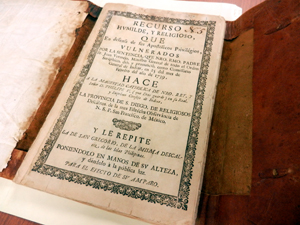
petition from the Barefoot Monks to Philip V, King of Spain (1739, from the Mexico Documents Collection)
While nothing can replicate working with a physical copy of a petition from the Barefoot Monks to Philip V of Spain in the Special Collections Reading Room, the opportunity to share online these types of centuries-old documents alongside more recent materials highlighting distinct periods of Mexican history marks another exciting step for our larger Hispanic Collections. We invite you to enjoy the Mexico Documents Collection and look forward to assisting you in your research, whether online via the Digital Library or offline next time you are able to pay us a visit.
